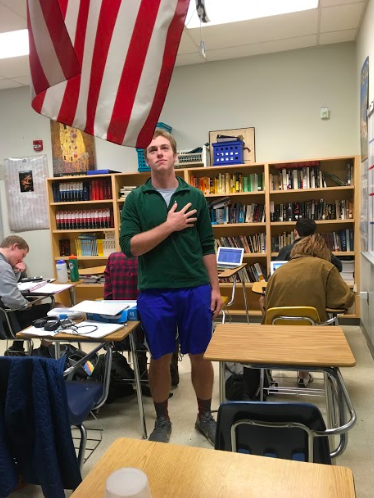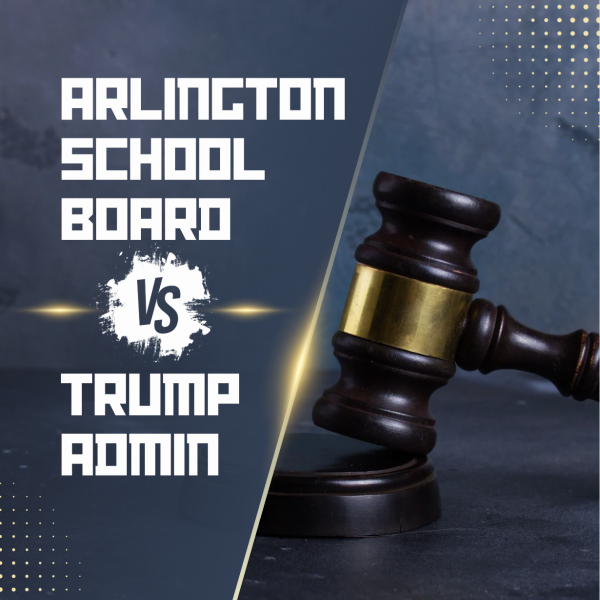Can’t stand it

Senior Owen Potts stands for Pledge of Allegiance at the beginning of their busy day. As staying seated for the pledge has become a popular form of protest, some have been offended by students’ choices not to stand.
Every morning, the bell indicating start of class rings and an administrator’s voice comes over the speakers, asking that the students stand and recite the Pledge of Allegiance with them. Some students stand and mumble along, some stand silently, and some choose to not stand at all. In 1943 the Supreme Court ruled in the landmark decision, West Virginia State Board of Education v. Barnette that the Free Speech Clause of the First Amendment protects students from being forced to say the Pledge of Allegiance in public school. Still, it is a tension-filled topic for some teachers and students.
There are many reasons that a student might choose not to stand for the pledge. Some atheists choose to stay seated because it contains the phrase “under God”. Some choose to sit in protest. However, a large amount of students stay seated out of convenience.
“There’s probably some who sit to protest, but very few,” junior Ziad Kamil said. “In freshman year I used to sit out of contempt, but now mostly because I’m usually getting ready for my first block class.”
Unfortunately for students who are sitting in protest, the number of other students who are sitting just because they feel like it leads to the loss of any political message.
“The statement made from not standing for the pledge is very broad and has many interpretations,” Kamil said. “If people actually wanted to make a statement, it would require national or at least regional coordination to not stand with an actual message. But that isn’t happening, so I don’t think anybody cares, or even thinks about it.”
Despite the students who choose to sit, a large part of the student body will stand for the pledge, and there are several students who feel strongly about it.
“I stand for the pledge because I love my country and respect the men and women who risk their lives to defend it and it doesn’t hurt to stand for 15 or so seconds,” senior Tony Castro said. “Standing for the pledge is my way of showing respect and honoring the flag.”
Even though Castro is proud to stand for the pledge, he agrees that teachers should not be able to tell a student to sit or stand.
“I don’t think teachers should force students to stand for the pledge,” Castro said. “It’s up to the student whether or not to stand for the pledge.”
Some teachers do not agree with that assessment and will go to great lengths to get their students to stand for the pledge.
“Every now and then there’s a few students will still don’t want to [stand] and I send them to the office,” physical education teacher Ms. Colleen Auerbach said. “I then get told that I’m not allowed to make them stand, but usually because I’ve made an issue about it, then most of the time they stand.”
Ms. Auerbach believes strongly in the right to free speech and power to protest, but thinks that sitting during the pledge is too disrespectful of a way to go about it.
“I think they should stand for the Pledge of Allegiance to be respectful. Maybe they don’t want to or they’re too lazy or they have political reasons to not stand, but they should stand for the Pledge of Allegiance for the people who have sacrificed for the right to protest,” Ms. Auerbach said. “In other countries, if you verbalize any discontent with the government or the politics, you get locked up or disappear or your family gets hurt. So you should stand for the right to be able to protest and to be able to not agree because you do have that freedom to vocalize. You want to stand up because of the freedoms that we have. Stand up because people sacrifice their lives for our way of life and our freedoms. Stand up because you can protest.”
Although Kamil, like many other students, is not protesting when he sits for the pledge, he is outraged by the idea of teachers attempting to make students stand for any reason.
“Forcing kids to stand has a specific message, being that you have to respect the country and that any form of protest will not be tolerated,” Kamil said. “Basically, teachers forcing students to stand indicates their politics to be more traditionalist, and forces students to follow them.”











